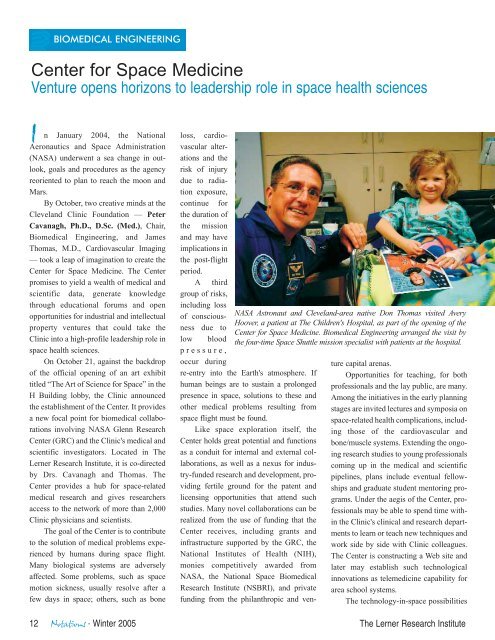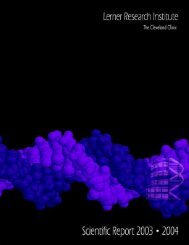The Lerner Research Institute Notations - Cleveland Clinic Lerner ...
The Lerner Research Institute Notations - Cleveland Clinic Lerner ...
The Lerner Research Institute Notations - Cleveland Clinic Lerner ...
- No tags were found...
You also want an ePaper? Increase the reach of your titles
YUMPU automatically turns print PDFs into web optimized ePapers that Google loves.
BIOMEDICAL ENGINEERINGCenter for Space MedicineVenture opens horizons to leadership role in space health sciencesIn January 2004, the NationalAeronautics and Space Administration(NASA) underwent a sea change in outlook,goals and procedures as the agencyreoriented to plan to reach the moon andMars.By October, two creative minds at the<strong>Cleveland</strong> <strong>Clinic</strong> Foundation — PeterCavanagh, Ph.D., D.Sc. (Med.), Chair,Biomedical Engineering, and JamesThomas, M.D., Cardiovascular Imaging— took a leap of imagination to create theCenter for Space Medicine. <strong>The</strong> Centerpromises to yield a wealth of medical andscientific data, generate knowledgethrough educational forums and openopportunities for industrial and intellectualproperty ventures that could take the<strong>Clinic</strong> into a high-profile leadership role inspace health sciences.On October 21, against the backdropof the official opening of an art exhibittitled “<strong>The</strong> Art of Science for Space” in theH Building lobby, the <strong>Clinic</strong> announcedthe establishment of the Center. It providesa new focal point for biomedical collaborationsinvolving NASA Glenn <strong>Research</strong>Center (GRC) and the <strong>Clinic</strong>'s medical andscientific investigators. Located in <strong>The</strong><strong>Lerner</strong> <strong>Research</strong> <strong>Institute</strong>, it is co-directedby Drs. Cavanagh and Thomas. <strong>The</strong>Center provides a hub for space-relatedmedical research and gives researchersaccess to the network of more than 2,000<strong>Clinic</strong> physicians and scientists.<strong>The</strong> goal of the Center is to contributeto the solution of medical problems experiencedby humans during space flight.Many biological systems are adverselyaffected. Some problems, such as spacemotion sickness, usually resolve after afew days in space; others, such as boneloss, cardiovascularalterationsand therisk of injurydue to radiationexposure,continue forthe duration ofthe missionand may haveimplications inthe post-flightperiod.A thirdgroup of risks,including lossof consciousnessdue tolow bloodNASA Astronaut and <strong>Cleveland</strong>-area native Don Thomas visited AveryHoover, a patient at <strong>The</strong> Children's Hospital, as part of the opening of theCenter for Space Medicine. Biomedical Engineering arranged the visit bythe four-time Space Shuttle mission specialist with patients at the hospital.pressure,occur duringre-entry into the Earth's atmosphere. Ifhuman beings are to sustain a prolongedpresence in space, solutions to these andother medical problems resulting fromspace flight must be found.Like space exploration itself, theCenter holds great potential and functionsas a conduit for internal and external collaborations,as well as a nexus for industry-fundedresearch and development, providingfertile ground for the patent andlicensing opportunities that attend suchstudies. Many novel collaborations can berealized from the use of funding that theCenter receives, including grants andinfrastructure supported by the GRC, theNational <strong>Institute</strong>s of Health (NIH),monies competitively awarded fromNASA, the National Space Biomedical<strong>Research</strong> <strong>Institute</strong> (NSBRI), and privatefunding from the philanthropic and venturecapital arenas.Opportunities for teaching, for bothprofessionals and the lay public, are many.Among the initiatives in the early planningstages are invited lectures and symposia onspace-related health complications, includingthose of the cardiovascular andbone/muscle systems. Extending the ongoingresearch studies to young professionalscoming up in the medical and scientificpipelines, plans include eventual fellowshipsand graduate student mentoring programs.Under the aegis of the Center, professionalsmay be able to spend time withinthe <strong>Clinic</strong>'s clinical and research departmentsto learn or teach new techniques andwork side by side with <strong>Clinic</strong> colleagues.<strong>The</strong> Center is constructing a Web site andlater may establish such technologicalinnovations as telemedicine capability forarea school systems.<strong>The</strong> technology-in-space possibilities12 <strong>Notations</strong> · Winter 2005 <strong>The</strong> <strong>Lerner</strong> <strong>Research</strong> <strong>Institute</strong>
















